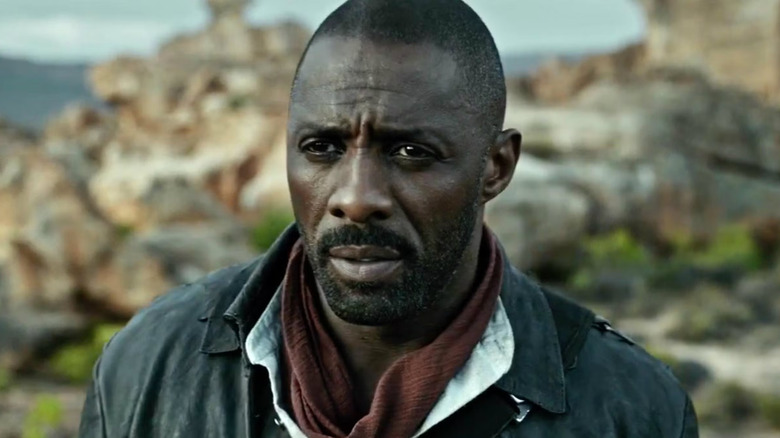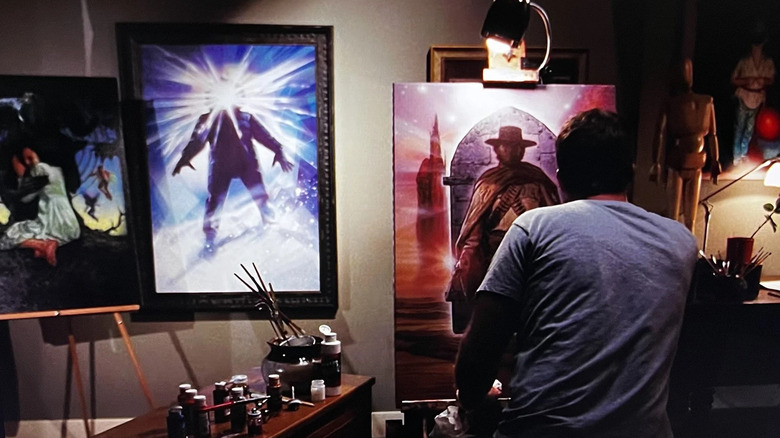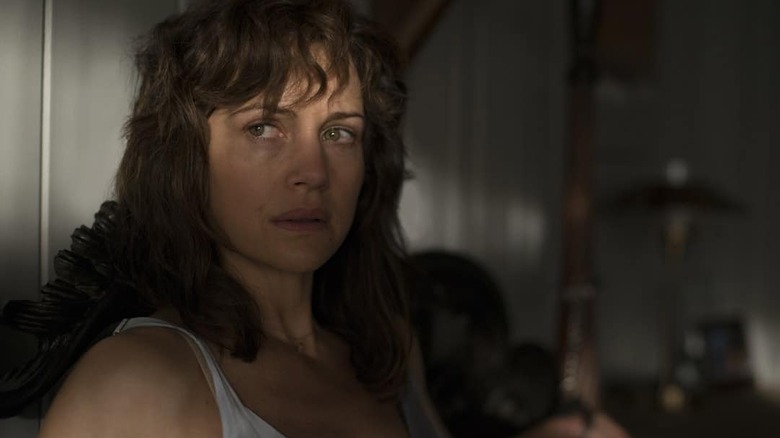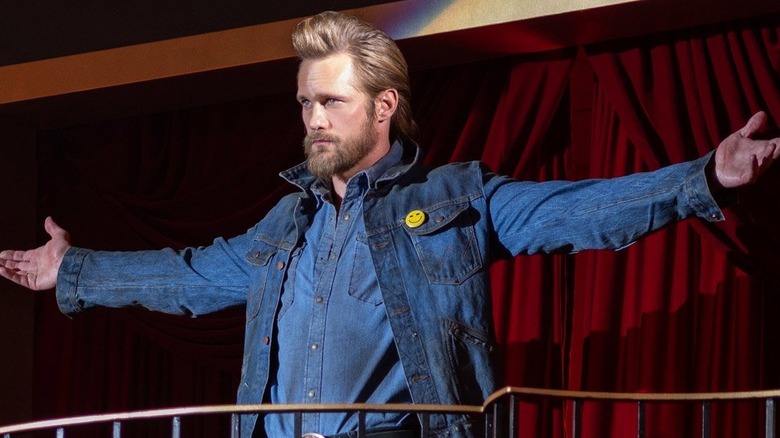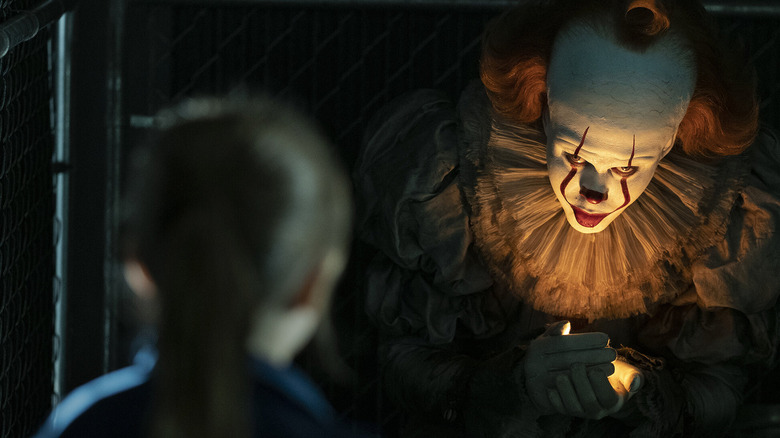5 Hidden References To The Dark Tower In Other Stephen King Movies
Fans of Stephen King's expansive fantasy series "The Dark Tower" have had a pretty rough go of it when it comes to screen adaptations, with only the (extremely subpar) 2017 movie trying to tell the tale of gunslinger Roland Deschain and his epic journey toward the titular tower. Now it seems like there might actually be a proper streaming adaptation courtesy of Mike Flanagan, who directed great takes on King stories with both "Doctor Sleep" and "Gerald's Game," with elements penned by King himself, which is kind of a dream come true.
Because "The Dark Tower" connects a great deal of King's work on the printed page, there are some pretty big references to the "Dark Tower" novels in other King adaptations, giving fans a tiny bit of hope over the years that maybe someday we would get to meet Roland, his ka-tet, and maybe even Blaine the train, that pain. Let's take a look at five of the biggest references to the world of "The Dark Tower" in other Stephen King movies (and mini-series), from the rather obvious to the slightly more obscure.
Thomas Jane paints The Dark Tower's hero in The Mist
In Frank Darabont's 2007 movie adaptation of King's novel "The Mist," we see the film's protagonist, David Drayton (Thomas Jane), working on an impressive painting during the opening scenes. His studio has a number of gorgeous paintings in it, including the cover to the 1982 John Carpenter movie "The Thing" and art for the 2006 Guillermo del Toro film "Pan's Labyrinth," and in the background there's a painting of a young person holding a red balloon (referencing King's nightmarish novel "It"). The painting he's working on, however, is of Roland, dressed in his gunslinger gear and standing in front of a large metal door, with the dark tower in the far background (the real artist of the paintings we see in this scene is legendary poster painter Drew Struzan, by the way). But how would David know about Roland?
In the "Dark Tower" books, King introduces the idea of a "thinny," or locations where realities blur a bit and people and items from different worlds can appear in others. It's possible that the little town in Maine where "The Mist" takes place is close to a thinny, or it's possible that David is someone capable of tapping into those realities through powers similar to Danny Torrance (and others) in "The Shining." It's also entirely possible that Darabont just wanted to give a nod to other King works. Whatever the case, the art is seriously cool and it's a fun moment in an otherwise total bummer of a movie.
Doctor Sleep and The Shining tie into The Dark Tower's mysticism
There are quite a few "Dark Tower" ties between King's novel "The Shining" and its sequel, "Doctor Sleep," including the haunted Overlook hotel having 19 steps from its lobby to the second floor — notable because 19 is a cosmic number in the connected multiverses of "The Dark Tower." Since writer and director Mike Flanagan is a huge fan of "The Dark Tower," he incorporated references into his excellent film adaptation of "Doctor Sleep," including the number 19 on a young baseball player Bradley's (Jacob Tremblay) jersey and fun naming conventions like a bus line being called "Tet Transit," after the Tet Corporation of "Dark Tower." The industrial complex where Bradley is buried is also owned by the evil LaMerk Industries from "Dark Tower" as well, and we can see posters for performances from an alternate identity of the "Dark Tower" monster Dandelo in the background of one scene, but one line outshines them all when it comes to referencing King's most epic work.
The biggest onscreen connection between "Doctor Sleep" and "The Dark Tower" comes when the ghost of Dick Hallorann (Carl Lumbly) speaks it aloud, saying "Ka is a wheel." This is a direct line from the novels, which explains one of the great driving forces in King's multiverse: ka. Ka is sort of like the Force from "Star Wars," in very simplistic terms, as it binds all things together and pushes time forward. Ka is destiny, just as a "ka-tet" are a group of heroes bound by destiny. (In the "Doctor Sleep" novel, Danny refers to the group he assembles to stop the vampire-like True Knot as a ka-tet.) Flanagan has said he might include some of the characters from "Doctor Sleep" in his "Dark Tower" series, and the path is honestly already set for that to happen.
A sinister phrase connects Gerald's Game to the Tower
There's a pretty intense connection between another Stephen King adaptation courtesy of Mike Flanagan, and that's in his utterly harrowing thriller "Gerald's Game." While both the novel and movie for "Gerald's Game" have a direct connection to King's novel "Dolores Claiborne," because the two women can speak to one another through some kind of telepathy (is it the shining? is it something more like King's "The Dead Zone?" Who knows?!), in Flanagan's movie there's also a tie to "The Dark Tower" that's super unsettling. Sure, it's pretty nasty to watch Jessie (Carla Gugino) de-glove the skin of her own hand in order to escape handcuffs, but something said to her by Gerald (Bruce Greenwood) might be even worse, psychologically.
Flanagan himself pointed out the connection in an interview with /Film back in 2017, saying:
"There's a really critical nod to 'The Dark Tower' that happens toward the end of the movie in a line that Bruce Greenwood says to Carla, which is "All things serve the beam." That was one I really wanted to make sure we got in there just because I'm a 'Dark Tower' fanatic."
But what does "all things serve the beam" mean? In "The Dark Tower," it means that all universes and timelines are connected, and all serve the same greater goal. While that might not seem too scary, it does also mean that the supernatural elements in "Gerald's Game" probably aren't all just in her mind, and there's very real mystical danger in each and every universe.
The Stand's Randall Flagg is also a Dark Tower baddie
So if "all things serve the beam" and all of the timelines are connected, does that mean all of the Stephen King worlds are connected? Some fans think so, but there are a whole bunch of clear connections that you don't really have go to searching for new ones. One of the biggest baddies in all of King lore is Randall Flagg, the antagonist of his epic-length apocalyptic novel "The Stand," who serves as a pretty great stand-in for the antichrist. Played by Jamey Sheridan in the 1994 miniseries and by Alexander Skarsgård in the 2020 limited series, Flagg is a truly terrifying villain that has a whole lot of charm despite looking like an everyman. In "The Dark Tower," however, he's The Walkin' Dude/The Man in Black/Walter, one of several antagonists working under an even scarier villain, the Crimson King.
Flagg has many faces and even shows up in King's "The Shawshank Redemption," making him one of the few characters that weave throughout the man stories instead of simply being loosely connected by them. "The Stand" is one of King's best works, and like "The Dark Tower," the adaptations just haven't lived up to the source material yet (even if Flanagan is a die-hard fan of the 1994 miniseries). He's not the only monster that links King's works, however, as a much more visually memorable villain has his own ties to "The Dark Tower."
It's Pennywise has his own Dark Tower connection
There's one last big Stephen King movie/"The Dark Tower" connection (not counting the actual "The Dark Tower" movie from 2017, of course), though this one's not quite as direct as any of the above. Remember Dandelo, the shape-shifting being who appears on posters as an Easter egg in "Doctor Sleep"? Dandelo is the same kind of extraterrestrial monster as It, who takes the frightening form of Pennywise the Dancing Clown in King's 1986 novel "It" and its two onscreen adaptations. It, played by Tim Curry in the 1990 miniseries and Bill Skarsgård in the 2017 and 2019 films "It" and "It Chapter Two," has a true form that's closer to a giant space spider, just like Dandelo. They're from the same place and are therefore both in service of the beam, connecting "It" and "The Dark Tower."
King has said that it's possible that Flagg and It are actually one and the same, though it's likely he means they're just parts of the same evil and not actually a singular entity. Look, it's far from the weirdest theory out there concerning King's work or even Pennywise, as some fans have theorized that Mary Poppins (yes, the flying nanny with the umbrella from the Disney movies) is actually the same kind of being as It and Dandelo. Now that's wild. Maybe we'll get some new fun Easter eggs when Flanagan's series eventually debuts on Prime Video, but for now we have these delicious connections to tide us over.
